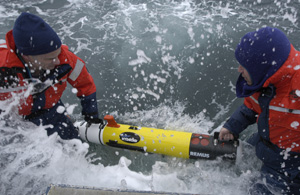Outer Cape Project
Onset of wintertime cooling brings dramatic changes to the structure of coastal and shelf waters. The mixed layer deepens, penetrating to the bottom in shallow regions. As a result, a complex structure of mixing fronts evolves. This dynamic nearshore structure, in turn, has a profound effect on coastal circulation and the distribution of biological and biogeochemical resources on the continental shelf. The depth of the mixed layer penetration and configuration of an emerging mixing front is determined by a number of interconnected factors: background temperature and salinity distribution, surface heat and freshwater fluxes, tidal and wind mixing.
We are conducting a detailed study of wintertime changes in stratification of coastal waters east of Cape Cod, MA, the relationship of these changes to atmospheric forcing, and their effect on the coastal and offshore ecosystems. The study involves the intensive use of Autonomous Underwater Vehicle (AUV) REMUS, combined with hydrographic, remote, and moored observations.
The questions we want to answer are the following:
- What is the basic response of shelf stratification to wintertime cooling? In particular, what are the effects of winter storms?
- What are the respective roles of salinity and temperature in establishing cross-shore density structure in different seasons?
- What are the effects of wind and tidal mixing on the frontal structure?
- What are fluctuations in alongshelf transport of fresh water and buoyancy from the Outer Cape Cod to the Great South Channel?
- What are the typical timescales of cooling and freshwater transport? How do they affect the temporal evolution of the front?
- How does the stratification changes affect chlorophyll distribution on the shelf?

